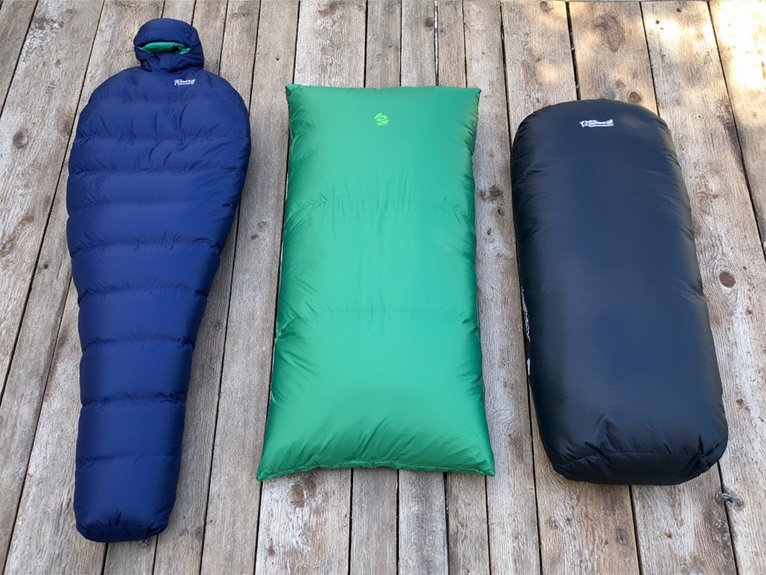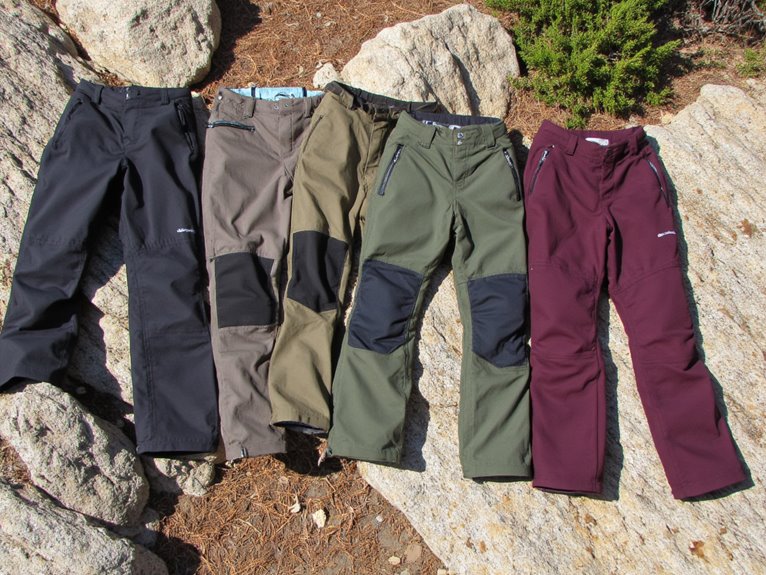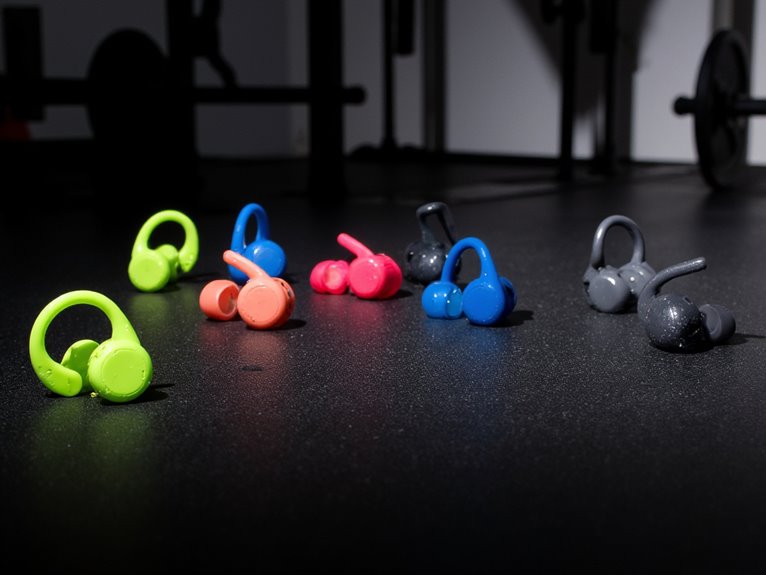Do You Take Clothes off in Sleeping Bag?
When sleeping in cold weather, it's essential to dress in layers and choose the right clothing to wear inside your sleeping bag to maintain body heat and prevent heat loss. Wearing a breathable base layer, such as merino wool or synthetic fabric, helps regulate body temperature. Mid-layers like fleece or down insulation can be added for extra warmth. However, avoid cotton as it retains moisture, leading to heat loss. Experiment with different layer combinations to find your ideal sleeping temperature. By understanding the importance of layering and choosing the right clothing, you'll be well on your way to a comfortable night's sleep – and the perfect sleeping system is just around the corner.
We are supported by our audience. When you purchase through links on our site, we may earn an affiliate commission, at no extra cost for you. Learn more. Last update on 25th December 2025 / Images from Amazon Product Advertising API.
Sleeping Bag Temperature Ratings
Sleeping bag temperature ratings are essential for ensuring a comfortable and safe outdoor adventure, as they provide a standardized way to compare the warmth of different sleeping bags.
These ratings indicate the lowest temperature at which a sleeping bag is designed to keep a person warm.
Typically, sleeping bags are rated for comfort, limit, and extreme temperatures.
The comfort rating is the temperature at which a user will feel comfortable, the limit rating is the lowest temperature at which a user can survive, and the extreme rating is the lowest temperature at which a user can survive for a short period.
Understanding these ratings is vital for choosing the right sleeping bag for your outdoor adventure.
Dressing for Cold Weather
When venturing into cold weather, dressing appropriately is essential to maintaining body heat and preventing heat loss, as even slight temperature drops can greatly impact overall comfort and safety.
It's vital to choose clothing that provides adequate insulation, breathability, and moisture-wicking properties.
Opt for fabrics like merino wool, fleece, or synthetic materials that retain warmth even when wet. Avoid cotton as it absorbs moisture, leading to heat loss.
Dress in loose, layered clothing to allow for airflow and adjustability.
Consider a hat and gloves to prevent heat loss from the head and hands.
Layering for Comfort
In terms of layering for comfort in sleeping bag clothes, the foundation of a comfortable sleep system lies in the layering strategy.
The base layer, often overlooked, plays a vital role in regulating body temperature and moisture wicking.
Base Layers Matter
By choosing the right base layers, outdoor enthusiasts can substantially improve their overall comfort and performance during camping trips.
Base layers provide the foundation for a comfortable night's sleep, regulating body temperature and wicking away moisture.
Merino wool, silk, or synthetic fabrics are popular choices for their breathability and moisture-wicking properties.
Avoid cotton as it retains moisture, making you feel clammy and cold.
Opt for a snug-fitting base layer that allows for a full range of motion.
Consider the temperature rating of your sleeping bag and dress accordingly.
For colder nights, wear thicker base layers, and for warmer nights, opt for lighter options.
Mid-Layer Choices
Mid-layer choices, typically consisting of fleeces, sweaters, or insulated jackets, play a crucial role in regulating body heat and providing extra warmth on chilly nights.
These layers should be breathable, moisture-wicking, and quick-drying to prevent overheating and discomfort.
Synthetic or down-filled insulated jackets are excellent options for cold weather camping. Fleece jackets or sweaters are suitable for milder temperatures.
When selecting a mid-layer, consider the activity level, campsite temperature, and personal comfort preferences.
A well-chosen mid-layer can make a significant difference in sleeping comfort, allowing for a restful night's sleep.
Merit of Wearing Base Layers
Wearing base layers provides a next-to-skin layer of moisture-wicking fabric that helps regulate body temperature and prevent chilling.
This is especially important when sleeping in a sleeping bag, as it helps maintain a comfortable body temperature and prevents overheating or chilling.
Base layers are designed to fit snugly, allowing for a full range of motion while sleeping.
Moisture-wicking fabrics help draw sweat away from the skin, reducing clamminess and discomfort.
Base layers can be worn in a variety of temperatures, making them a versatile choice for camping trips.
They are often quick-drying, reducing the risk of chill when getting in and out of the sleeping bag.
Mid-Layer Options for Insulation
Frequently, campers find that adding a mid-layer of insulation helps to fine-tune their sleeping temperature, providing an extra layer of warmth on chilly nights.
Mid-layers can be made of various materials, such as fleece, down, or synthetic insulation.
Fleece mid-layers are lightweight, breathable, and quick-drying, making them ideal for milder temperatures.
Down mid-layers offer superior warmth-to-weight ratio, but may not perform well in wet conditions.
Synthetic insulation, on the other hand, provides reliable warmth even when wet.
When choosing a mid-layer, consider factors such as weight, compressibility, and moisture-wicking properties to guarantee a comfortable and restful night's sleep.
Outerwear in Sleeping Bag
In terms of outerwear in a sleeping bag, there are several key considerations to keep in mind.
One vital decision is whether to wear an insulating jacket inside the bag or rely on a fleece layer within the bag for warmth.
Additionally, the choice to wear pants or not can also impact overall comfort and temperature regulation during sleep.
Insulating Jacket Inside
By integrating an insulating jacket inside the sleeping bag, outdoor enthusiasts can substantially boost the overall thermal performance of their sleeping system. This setup allows the jacket's insulating properties to work in tandem with the sleeping bag, trapping warm air and keeping the cold out. As a result, campers can enjoy a more comfortable and restful night's sleep.
Reduces heat loss by filling gaps between the body and sleeping bag.
Increases the sleeping bag's temperature rating.
Allows for a more comfortable sleeping temperature range.
Enables campers to use a lighter-weight sleeping bag.
Provides an extra layer of warmth in extremely cold conditions.
Fleece in the Bag
Incorporating a fleece layer directly into the sleeping bag, also known as 'fleece in the bag,' offers an innovative approach to enhancing thermal insulation and comfort during outdoor adventures.
This technique allows campers to maintain a consistent body temperature, even in extremely cold conditions.
By wearing a fleece jacket or pullover inside the sleeping bag, the camper's body heat is retained more efficiently, reducing heat loss and promoting a restful night's sleep.
Additionally, the fleece layer can help regulate body temperature, preventing overheating or chilling.
This approach is particularly useful for campers who tend to feel cold while sleeping or for those who camp in extremely cold climates.
Pants On or Off
While the incorporation of fleece in the sleeping bag provides excellent thermal insulation, the question remains as to whether wearing outerwear, such as pants, inside the sleeping bag is beneficial or detrimental to a camper's overall comfort and warmth.
Wearing pants inside the sleeping bag can have both positive and negative effects.
- Moisture buildup: Wearing pants can increase moisture buildup inside the sleeping bag, reducing its insulating capacity.
- Restricted movement: Pants can restrict movement and comfort inside the sleeping bag.
- Added warmth: Wearing pants can provide additional warmth, especially in extremely cold temperatures.
- Personal preference: Some campers prefer wearing pants for extra comfort and warmth, while others find it restrictive.
- Sleeping bag design: Some sleeping bags are designed to accommodate outerwear, while others are not.
Sleeping Bag Insulation Types
Three primary types of insulation are commonly used in sleeping bags, each with its own unique characteristics, advantages, and disadvantages.
Down insulation, often preferred by backpackers, provides exceptional warmth-to-weight ratio and compressibility.
However, it loses insulating properties when wet.
Synthetic insulation, on the other hand, retains its warmth even when damp, making it an excellent choice for wet or humid conditions.
Hybrid insulation combines the benefits of both, offering a balance between warmth, weight, and water resistance.
When choosing a sleeping bag, understanding the strengths and weaknesses of each insulation type is vital to making a successful selection that results in a comfortable and restful night's sleep in the great outdoors.
Personal Comfort Level Matters
When dealing with sleeping bag clothes, personal comfort level matters greatly.
Two essential aspects are body temperature regulation and personal space boundaries, as they directly impact the quality of rest and overall sleeping experience.
Body Temperature Regulation
Maintaining a desirable body temperature, typically between 97°F and 100°F (36°C and 38°C), is essential for a comfortable night's sleep, as even slight deviations can substantially impact the quality of rest. A comfortable body temperature guarantees a restful and rejuvenating sleep.
To achieve this, it's vital to adjust your clothing and sleeping bag accordingly.
Key factors for regulating body temperature effectively include:
- Dress in layers to adjust to changing body temperature
- Select a sleeping bag with a suitable temperature rating
- Take into account the ambient temperature and humidity
- Avoid overheating, which can lead to discomfort and restlessness
- Experiment to find your ideal sleeping temperature and clothing combination
Personal Space Boundaries
A comfortable sleeping environment is not only about regulating body temperature, but also about establishing personal space boundaries that respect individual comfort levels and promote restful sleep.
In the context of sleeping in a sleeping bag, personal space boundaries play a vital role in determining how much clothing to wear. Some people prefer to wear minimal clothing to feel unrestricted, while others prefer to wear layers for a sense of security and comfort.
It's essential to listen to your body and identify what makes you feel comfortable and relaxed. In the matter of sleeping arrangements, personal space boundaries are key in determining how much clothing to wear.
Sleeping Bag Liner Benefits
Most outdoor enthusiasts agree that incorporating a sleeping bag liner into their camping gear can substantially improve the overall sleeping experience. Not only does it provide an extra layer of warmth, but it also offers several other benefits.
Added warmth: Sleeping bag liners can increase the temperature rating of your sleeping bag by up to 10°C (18°F).
Easy cleaning: Liners are much easier to clean than sleeping bags, making them a practical addition to your camping gear.
Moisture protection: Liners can help protect your sleeping bag from moisture and humidity.
Customization: Sleeping bag liners come in a range of materials and thicknesses, allowing you to customize your sleeping setup.
Extended sleeping bag lifespan: Using a liner can help reduce wear and tear on your sleeping bag, extending its lifespan.
Best Practices for Camping
When venturing into the great outdoors, understanding best practices for camping can substantially improve your overall experience and guarantee a safe, enjoyable, and environmentally responsible adventure.
To facilitate a successful camping trip, always research the campsite and weather conditions beforehand. Pack essential gear, including a first-aid kit, and check the condition of your equipment.
Upon arrival, choose a flat and dry spot to set up camp, and follow Leave No Trace principles to minimize your impact on the environment.
Build a safe and controlled campfire, and keep a bucket of water and a fire extinguisher nearby.
Finally, respect wildlife and other campers, and follow all campsite rules and regulations.




